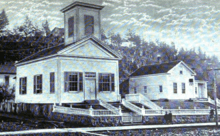Religion in Oregon

Religion in the state of Oregon is unique in the United States, with the highest percentage of religiously unaffiliated adults in the entire nation (37%).[1]
History
In 1836, French Canadian pioneers on the French Prairie in the Willamette Valley built a log cabin chapel along the Willamette River.[2] The first Protestant church in Oregon was built in Oregon City starting in 1842.[3] Completed in 1844, this Methodist church was also the first Protestant church on the continental West Coast of what became the United States.[3] The first Roman Catholic official presence in Oregon was the apostolic vicariate for the Oregon Territory begun in 1843. By 1846, the archdiocese of Oregon was formally established. Informally considered part of the Unchurched Belt, Oregon is known for historically having a lack of religiosity compared to other U.S. states.
Current statistics
Lack of religiosity
A 2003 study, released once every 10 years, listed Benton County, Oregon as the least religious county per capita in the United States. Only 1 in 4 people indicated that they were affiliated with one of the 149 religious groups the study identified. The study indicated that some of the disparity, however, may be attributed to the popularity of less traditional religions (ones not included as an option in the study) in the Pacific Northwest.[4]
In a 2009 Gallup poll, Oregon ranked #1 of US states with the highest percentage of residents who were unaffiliated with any religion, at 24.6%.[5] Although 46% of Oregonians identify religion as being "very important", a full 40% of Oregonians (including those affiliated with a religion) seldom or never attend services.[6]
In a different 2009 Gallup poll, Oregon was ranked as the seventh least religious state. In response to the question, "Is religion an important part of your life?", 53% of Oregonians responded "yes". The most religious state was Mississippi, with 85%, and the least religious state was Vermont, with 42%. The states less religious than Oregon, in order, are Washington, Alaska, Massachusetts, Maine, New Hampshire, and Vermont.[7] In a 2006 Gallup poll, Oregonians tied for seventh state with the lowest church attendance, at 32%, along with California and Washington. Church attendance ranged from 58% to 24% in the poll.[8]
A 2015 study from the Public Religion Research Institute placed the percentage of unaffiliated individuals at 37% in 2014.[1]
Denominations
A Pew Research Center study reported on by The Oregonian in February 2008, found that Oregon's largest religious group (among Christians and in general) was Catholics, at 14%. All denominations of Protestant accounted for 30%, Mormons for 5%, Buddhists for 2%, and unaffiliated for 27%, all higher than the national average.[9][10] A 2009 Gallup poll found that 69% Oregonians identified with a Christian religion.[5]
30% of Oregonians identify themselves as evangelical Christians, higher than the national average of 26%.[11] Oregon was lower than the national average in people who identify as mainline Protestants, historically black Christians, Catholics, Orthodox Christians, Jehovah's Witnesses, Jews and Muslims. Oregon tracks the national average in its number of Hindus.[12] The largest denominations by number of adherents in 2000 were the Roman Catholic Church with 348,239; The Church of Jesus Christ of Latter-day Saints with 104,312; and the Assemblies of God with 49,357.[13]
While Oregon has higher than average rates of evangelical Christianity and Mormonism compared to mainline or orthodox sects of Christianity, Judaism and Islam, it does have a slightly higher percentage of Buddhists regardless of sect,[14] and is part of an overall growth in Buddhists not of ethnically Asian origin in the West.[15] Oregon also contains the largest community of Russian Old Believers to be found in the United States (nearly 10,000 as of 2002),[16] due to a relatively large immigrant population from areas where the church originated.
See also
- History of Oregon
- History of religion in the United States
- Irreligion in the United States
- List of Roman Catholic religious communities in Oregon
- Politics of Oregon
- Religion in the United States
- Roman Catholic Archdiocese of Portland
- The Church of Jesus Christ of Latter-day Saints in Oregon
References
- 1 2 https://ava.publicreligion.org/#religious/2014/States/religion/16
- ↑ Chapman, J. S. (1993). French prairie ceramics: the Harriet D. Munnick archaeological collection, circa 1820-1860 : a catalog and Northwest comparative guide. Anthropology northwest, no. 8. Corvallis, Or: Dept. of Anthropology, Oregon State University.
- 1 2 Horner, John B. (1919). Oregon: Her History, Her Great Men, Her Literature. Portland: The J.K. Gill Company. p. 83.
- ↑ Reeves, Carol (2003-12-21). "Where are the faithful?". Corvallis Gazette-Times. Retrieved 2009-02-28.
- 1 2 http://www.gallup.com/poll/122075/Religious-Identity-States-Differ-Widely.aspx#2 Retrieved 2009-12-25
- ↑ "Religion and Politics 2008: Oregon". The Pew Forum on Religion and Public Life. Pew Research Center. Archived from the original on December 18, 2008. Retrieved 2009-02-08.
- ↑ http://www.gallup.com/poll/114022/state-states-importance-religion.aspx#2 Retrieved 2009-12-25
- ↑ Newport, Frank (2006-04-27). "Church Attendance Lowest in New England, Highest in South". Gallup. Retrieved 2009-02-28.
- ↑ http://blog.oregonlive.com/mapesonpolitics/2008/02/survey_dissects_oregons_thorny.html Retrieved 2010-01-09
- ↑ http://religions.pewforum.org/maps Retrieved 2010-01-09
- ↑ "Oregon keeps title of most secular". The Register-Guard. Guard Publishing. 2008-02-26. Retrieved 2009-01-17.
- ↑ Haught, Nancy (2008-02-26). "The state of religion in Oregon". The Oregonian. Advance Publications. p. A04.
- ↑ "State Membership Report - Oregon". Association of Religion Data Archives. Retrieved 2009-02-07.
- ↑ "Buddhism makes gains in the region". The Spokesman-Review. Cowles Publishing Company. 2003-12-01.
- ↑ Taylor, Kate (2005-10-22). "More Americans buying into Buddhism". The Seattle Times. The Seattle Times Company.
- ↑ Binus, Joshua (2005). "The Oregon History Project: Russian Old Believers". Oregon Historical Society. Retrieved 2009-02-07.
